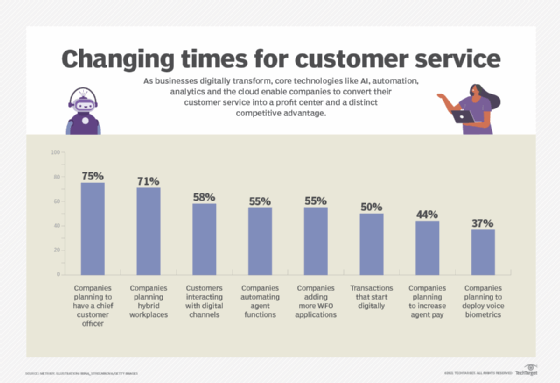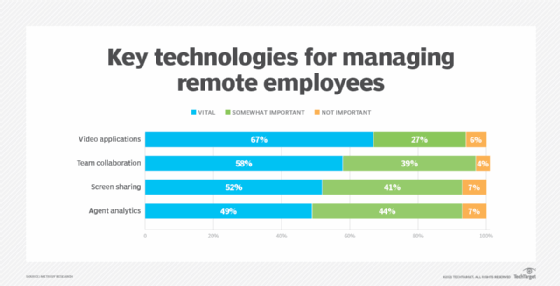The future of customer service: 12 trends to watch
Advanced technologies continue to shape customer service goals to streamline digital workflows, increase positive experiences, lower agent turnover and improve contact center ROI.
The future of customer service increasingly will be driven by technology innovations. Ideally, these new technologies will improve customer and agent experiences, along with business metrics like revenue, operational costs and customer ratings. But businesses often miss the mark when they try to move too quickly with too much technology, ultimately resulting in consumer dissatisfaction rather than elation.
Customer expectations for what defines a good experience stay fairly consistent over time, but the approach to providing that experience changes. Meanwhile, advanced technologies, largely driven by artificial intelligence, analytics and automation, arm companies with new techniques for driving customer satisfaction and loyalty.
How are customer expectations changing?
Over the years, customer expectations generally haven't changed. Customers want to be served quickly and completely on the first try. If they're speaking to a human agent, they want a friendly, knowledgeable interaction -- the goal being to resolve the customer's problem or answer their question quickly and easily.
Drilling down, however, customer expectations are influenced by the changes in technology. Just five years ago, for example, few customers would have expected to communicate with businesses over SMS or messaging services from their mobile phone. Now, it's common because consumers use those applications in other areas of their lives.
Perhaps the biggest area of change is the interaction channels used to communicate with businesses. Today, 58% of customers interact with digital channels, and 50% of all transactions start digitally, according to Metrigy's research. Consumers now expect to have several options for communication, including messaging apps like Facebook Messenger, WeChat, WhatsApp and Apple Business Chat, along with web chat, SMS, screen-sharing, video, self-service knowledge bases and FAQs, and chatbots.
Consumers also are more open to proactive outreach -- whether the customer service team is inviting them to a customer loyalty program or reminding them of an appointment -- so long as those reminders, confirmations and invitations arrive at their preferred application.

How is technology influencing the future of customer service?
Businesses can provide quick, contextual customer service with tools like analytics, agent assist and workforce optimization (WFO) for agents in the contact center, as well as customer-facing tools such as self-service, chatbots and personalization.
At the core of most new technologies are the three As -- artificial intelligence, automation and analytics. Working together, these technologies can provide organizations with advice, context, results and metrics for improvement, but it's imperative to roll out deployments cautiously instead of trying to boil the ocean. Businesses will then be able to identify how well these customer service tools address specific problems or opportunities and evaluate their performance through analytics.
Technology should improve customer service, customer experiences and agent satisfaction and continue to raise the bar for meeting customer expectations.
12 trends that are changing the future of customer service
Several customer service trends are changing future interactions and expectations.
1. Hybrid workplaces
Planned by 71% of companies, hybrid workplaces will increase the availability of agents, allowing companies to better respond to emergency or high-volume situations. If a weather issue is causing flight delays, for example, airlines can more easily call in agents off-hours because they can work from their home office instead of commuting to the contact center.
2. Chief customer officers
By the end of 2021, nearly 75% of companies had planned to have a chief customer officer on board. CCOs raise the visibility of customer experience to C-suite executives. They also conduct agent and voice-of-the-customer analysis to regularly evaluate and revise technology implementations.
3. Higher wages for agents, less turnover
In 2022, 44% of companies will increase agent pay. Chatbots and virtual assistants are replacing the functions of basic or entry-level agents. Agents are now required to be more experienced. Average pay ranges from $21.64 to $42.31 per hour. Higher pay, along with flexible work schedules, will help reduce agent turnover rates.
4. More virtual assistants and video
Virtual assistants and video are the two fastest-growing customer interaction channels. Virtual assistants help customers navigate websites and self-service portals, while video helps agents see what customers are doing and resolve their issues. As companies continue to add video, customer service will improve.
5. Workforce optimization
WFO is on the rise. In the past year, 55% of companies have added more WFO applications. Quality management, call/screen recording and performance management top the deployment list. WFO analytics tools help improve agent performance and, ultimately, customer service.

6. Automation of agent tasks
About 55% of companies are automating agent functions, resulting in a 34% improvement in agent efficiency. Each agent will be able to handle more functions, lowering overall operational costs. Those savings will more likely inspire companies to further invest in technologies and increase agent pay.
7. Upselling and cross-selling
Regardless of whether agents are in customer service or inside sales, they typically have upselling and cross-selling responsibilities. The challenge for agents will be to meet their quotas without taking away from quality customer service. If the upsell recommendation is helpful, customers will rate their experience positively. If they view the recommendation as an unsolicited sales pitch, they'll rate their experience lower.
8. Self-service and live agent deflection
Self-service and live agent deflection are top-of-mind among CX leaders. They're improving their knowledge bases with more multimedia content and pairing them with chatbots to help guide customers to a successful resolution. But if the customer is getting frustrated, the chatbot learns when to escalate to a live agent.
9. Voice biometrics
By the end of 2021, 37% of companies are planning to deploy voice biometrics. The technology typically reduces each call by 30 to 60 seconds, which increases customer satisfaction and decreases contact center costs.
10. Voice of the customer
Various departments, including customer service, sales, marketing and product development, are using voice-of-the-customer programs and analysis to make decisions, coach employees and improve products and services.
11. Platform integration
Companies are integrating platforms, namely unified communications (UC) and contact center, but some enterprises also are integrating CRM applications, resulting in improved customer service. When agents can't resolve an issue, they can connect a non-contact center expert to assist in the interaction.
12. Communications platform as a service
Customization will be key moving forward, and that's where communications platform as a service (CPaaS) comes into play. CX leaders can use custom apps, low-code/no-code development platforms and APIs to integrate the apps into their contact center or UC platforms. CPaaS provides apps such as click-to-call or SMS messaging to send reminders, delivery notifications and more.
On one level, customer service expectations will not change -- fast, friendly, contextual service with resolution on the first interaction. But how those expectations are met will vary based on technology innovations, the business applications of those innovations and how high the bar rises with every improvement.







